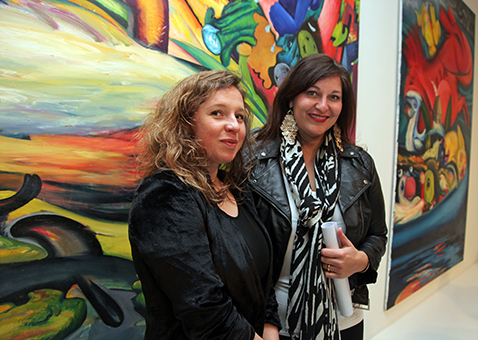empathy
Madame Oktopus: The Tentacles Around Us

“See, this is one of the reasons why I’m beginning to dislike painting more and more,” I remember telling a friend just five minutes after arriving at AJLart to see “Madame Oktopus.” “Once you perceive all that is on exhibit, there’s nothing else to do but to entertain yourself with drinks and banter.” My reaction must have been a result of the enclosed space of the lobby in which Maryna Baranovska’s large, colorful canvases hung. The claustrophobic space, particularly on opening night, did not allow for the introspection that Baranovska’s paintings require. You see, when visiting an exhibition on its opening night, it is often a risk for the works of art on display—especially of static media on the walls (i.e. painting and photography)—to become mere decorations in the background as artists, gallerists and visitors greet and converse in the foreground. But why is that the case? Has our fast-paced, internet-driven interaction taken a toll our patience and way of perceiving static visual art?
Acknowledging this problem, I decided to surrender to the claustrophobia and the pressures of greeting and conversing at “Madame Oktopus” during my stay and instead gave my undivided attention to the paintings on the wall. In the hour that followed, the paintings on display revealed to be more than I had erroneously envisioned after five minutes of walking in.
The Art Of Confronting A Painting
The large paintings (300cm x 200cm) of Marina Baranovska read as internal landscapes where we bear witness to the artist’s movement in her thoughts, inhibitions and playfulness. This is evident in her handling of paint; she stretches it, lets it drip, contains it or lets it evaporate. Before long, her paintings begin to read as sculptures, and the act of looking at them is one reminiscent of viewing massive clouds that morph and shape-shift across the sky on their way to who knows where.

You are never certain what her simultaneously cute and demonic creatures represent, where they come from or where they are going. But who is the lucky one among us that knows that answer for ourselves? It is an empathy bridge that gets built when one decides to spend a good amount of time confronting a painting. Both an empathy with the images but more importantly with the artist that once stood in front of the same painting, with her hands dirty and her thoughts racing.
Be the first to write a comment.
Your feedback
